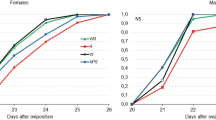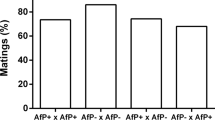Abstract
Camponotus is a hyper-diverse ant genus that is associated with the obligate endosymbiont Blochmannia, and often also with Wolbachia, but morphological studies on the location of these bacteria in the queen’s ovaries during oogenesis remain limited. In the present study, we used the Neotropical weaver ant Camponotus textor to characterize the ovary using histology (HE) techniques, and to document the location of Blochmannia and Wolbachia during oogenesis through fluorescence in situ hybridization (FISH). This is the first morphological report of these two bacteria in the same host with polytrophic meroistic ovaries and reveals that Blochmannia is found inside late-stage oocytes and Wolbachia is associated with the nuclei of the nurse cells. Our results provide insights into the developmental sequence of when these bacteria reach the egg, with Blochmannia establishing itself in the egg first, and Wolbachia only reaching the egg shortly before completing egg development. Studies such as this provide understanding about the mechanisms and timing of the establishment of these endosymbionts in the host.


Similar content being viewed by others
References
Andersen SB, Boye M, Nash DR, Boomsma JJ (2012) Dynamic Wolbachia prevalence in Acromyrmex leaf-cutting ants: potential for a nutritional symbiosis. J Evol Biol 25:1340–1350. https://doi.org/10.1111/j.1420-9101.2012.02521.x
AntWeb. https://www.antweb.org. Accessed 24 Feb 2017
Balmand S, Lohs C, Aksoy S, Heddi A (2013) Tissue distribution and transmission routes for the tsetse fly endosymbionts. J Invertebr Pathol 112:S116–S122. https://doi.org/10.1016/j.jip.2012.04.002
Barr AR (1980) Cytoplasmic incompatibility in natural populations of a mosquito, Culex pipiens L. Nature 283:71–72. https://doi.org/10.1038/283071a0
Blochmann F (1882) Über das Vorkommen bakterien€ahnlicher Gebilde in den Geweben und Eiern verschiedener Insekten. Zbl Bakt 11:234–240
Bolton B (2016) An online catalog of the ants of the world. http://www.antcat.org/. Accessed 20 Oct 2016
Brown BP, Wernegreen JJ (2016) Deep divergence and rapid evolutionary rates in gut-associated Acetobacteraceae of ants. BMC Microbiol doi. https://doi.org/10.1186/s12866-016-0721-8
Buchner P (1918) Vergleichende Eistudien 1. Die akzessorischen Kerne des Hymenoptereneies. Arch für Mikroskopische Anat 91:1–202. https://doi.org/10.1007/BF02978932
Casper-Lindley C, Kimura S, Saxton DS et al (2011) Rapid fluorescence-based screening for Wolbachia endosymbionts in Drosophila germ line and somatic tissues. Appl Environ Microbiol 77:4788–4794. https://doi.org/10.1128/AEM.00215-11
Degnan PH, Lazarus AB, Wernegreen JJ (2005) Genome sequence of Blochmannia pennsylvanicus indicates parallel evolutionary trends among bacterial mutualists of insects. Genome Res 15:1023–1033. https://doi.org/10.1101/gr.3771305
Feldhaar H, Straka J, Krischke M et al (2007) Nutritional upgrading for omnivorous carpenter ants by the endosymbiont Blochmannia. BMC Biol 5:48. https://doi.org/10.1186/1741-7007-5-48
Fenn K, Blaxter M (2004) Are filarial nematode Wolbachia obligate mutualist symbionts? Trends Ecol Evol 19:163–166. https://doi.org/10.1016/j.tree.2004.01.002
Fernandes TT, da Silva RR, de Souza DR et al (2012) Undecomposed twigs in the leaf litter as nest-building resources for ants (Hymenoptera: Formicidae) in areas of the Atlantic forest in the southeastern region of Brazil. Psyche A J Entomol 2012:1–8. https://doi.org/10.1155/2012/89647
Frydman HM, Li JM, Robson DN, Wieschaus E (2006) Somatic stem cell niche tropism in Wolbachia. Nature 441:509–512. https://doi.org/10.1038/nature04756
Genty L-M, Bouchon D, Raimond M et al (2014) Wolbachia infect ovaries in the course of their maturation: last minute passengers and priority travellers? PLoS ONE 9:e94577. https://doi.org/10.1371/journal.pone.0094577
Gil R, Silva FJ, Zientz E et al (2003) The genome sequence of Blochmannia floridanus: comparative analysis of reduced genomes. Proc Natl Acad Sci USA 100:9388–9393. https://doi.org/10.1073/pnas.1533499100
He L, Wang X, Montell DJ (2011) Shining light on Drosophila oogenesis: live imaging of egg development. Curr Opin Genet Dev 21:612–619. https://doi.org/10.1016/j.gde.2011.08.011
Hosokawa T, Koga R, Kikuchi Y et al (2010) Wolbachia as a bacteriocyte-associated nutritional mutualist. Proc Natl Acad Sci USA 107:769–774. https://doi.org/10.1073/pnas.0911476107
Junqueira LCU, Junqueira LMMS. (1983) Técnicas básicas de citologia e histologia. Santos, São Paulo
Klein A, Schrader L, Gil R et al (2016) A novel intracellular mutualistic bacterium in the invasive ant Cardiocondyla obscurior. ISME J 10:376–388. https://doi.org/10.1038/ismej.2015.119
Kose H, Karr TL (1995) Organization of Wolbachia pipientis in the Drosophila fertilized egg and embryo revealed by an anti-Wolbachia monoclonal antibody. Mech Dev 51:275–288. https://doi.org/10.1016/0925-4773(95)00372-X
Kupper M, Stigloher C, Feldhaar H, Gross R (2016) Distribution of the obligate endosymbiont Blochmannia floridanus and expression analysis of putative immune genes in ovaries of the carpenter ant Camponotus floridanus. Arthropod Struct Dev 45:475–487. https://doi.org/10.1016/j.asd.2016.09.004
Matta LSFDM., Santina De M, Morini MSC, Hilsdorf AWS (2013) Genetic relationship among Camponotus rufipes Fabricius (Hymenoptera:Formicidae) nests by RAPD molecular markers. Acta Sci Biol Sci Mar 35:89–92. https://doi.org/10.4025/actascibiolsci.v35i1.10913
Ramalho MO, Bueno OC, Moreau CS (2017) Species-specific signatures of the microbiome from Camponotus and Colobopsis ants across developmental stages. PLoS ONE 12:e0187461. https://doi.org/10.1371/journal.pone.0187461
Ramalho MO, Martins C, Silva LMR et al (2017) Intracellular symbiotic bacteria of Camponotus textor, Forel (Hymenoptera, Formicidae). Curr Microbiol. https://doi.org/10.1007/s00284-017-1201-6
Ramalho MO, Martins C, Silva LMR et al (2016) Molecular profile of the brazilian weaver ant Camponotus textor Forel (Hymenoptera, Formicidae). Neotrop Entomol 45:463–470. https://doi.org/10.1007/s13744-016-0392-z
Ramalho MO, Santos RM, Fernandes TT et al (2016) Cytochrome c oxidase I DNA sequence of Camponotus ants with different nesting strategies is a tool for distinguishing between morphologically similar species. Genetica 144:375–383. https://doi.org/10.1007/s10709-016-9906-1
Rousset F, Raymond M (1991) Cytoplasmic incompatibility in insects: why sterilize females? Trends Ecol Evol 6:54–57. https://doi.org/10.1016/0169-5347(91)90123-F
Russell JA (2012) The ants (Hymenoptera: Formicidae) are unique and enigmatic hosts of prevalent Wolbachia (Alphaproteobacteria) symbionts. Myrmecol News Myrmecol News 16:7–23
Russell JA, Sanders JG, Moreau CS (2017) Hotspots for symbiosis: function, evolution, and specificity of ant-microbe associations from trunk to tips of the ant phylogeny (Hymenoptera: Formicidae). Myrmecol News 24:43–69
Santos JC, Del-Claro K (2009) Ecology and behaviour of the weaver ant Camponotus (Myrmobrachys) senex. J Nat Hist 43:1423–1435. https://doi.org/10.1080/00222930902903236
Sauer C, Dudaczek D, Hölldobler B, Gross R (2002) Tissue localization of the endosymbiotic bacterium Candidatus Blochmannia floridanus in adults and larvae of the carpenter ant Camponotus floridanus. Appl Environ Microbiol 68:4187–4193. https://doi.org/10.1128/AEM.68.9.4187-4193.2002
Schröder D, Deppisch H, Obermayer M et al (1996) Intracellular endosymbiotic bacteria of Camponotus species (carpenter ants): systematics, evolution and ultrastructural characterization. Mol Microbiol 21:479–489. https://doi.org/10.1111/j.1365-2958.1996.tb02557.x
Stoll S, Feldhaar H, Fraunholz MJ, Gross R (2010) Bacteriocyte dynamics during development of a holometabolous insect, the carpenter ant Camponotus floridanus. BMC Microbiol 10:308. https://doi.org/10.1186/1471-2180-10-308
Stouthamer R, Breeuwer JAJ, Hurst GDD (1999) Wolbachia Pipientis: microbial manipulator of arthropod reproduction. Annu Rev Microbiol 53:71–102. https://doi.org/10.1146/annurev.micro.53.1.71
Szklarzewicz T, Kalandyk-Kolodziejczyk M, Kot M, Michalik A (2013) Ovary structure and transovarial transmission of endosymbiotic microorganisms in Marchalina hellenica (Insecta, Hemiptera, Coccomorpha: Marchalinidae). Acta Zool 94:184–192. https://doi.org/10.1111/j.1463-6395.2011.00538.x
Toomey ME, Panaram K, Fast EM et al (2013) Evolutionarily conserved Wolbachia-encoded factors control pattern of stem-cell niche tropism in Drosophila ovaries and favor infection. Proc Natl Acad Sci USA 110:10788–10793. https://doi.org/10.1073/pnas.1301524110
Veneti Z, Clark ME, Karr TL et al (2004) Heads or tails: host-parasite interactions in the Drosophila-Wolbachia system. Appl Environ Microbiol 70:5366–5372. https://doi.org/10.1128/AEM.70.9.5366-5372.2004
Wernegreen JJ, Kauppinen SN, Brady SG, Ward PS (2009) One nutritional symbiosis begat another: phylogenetic evidence that the ant tribe Camponotini acquired Blochmannia by tending sap-feeding insects. BMC Evol Biol 9:292. https://doi.org/10.1186/1471-2148-9-292
Werren JH (2005) Heritable microorganisms and reproductive parasitism. In: Sapp J (ed) Microbial phylogeny and evolution: concepts and controversies. Oxford University Press, Oxford, pp 290–315
Wolschin F, Hölldobler B, Gross R, Zientz E (2004) Replication of the endosymbiotic bacterium Blochmannia floridanus is correlated with the developmental and reproductive stages of its ant host. Appl Environ Microbiol 70:4096–4102. https://doi.org/10.1128/AEM.70.7.4096-4102.2004
Zchori-Fein E, Roush RT, Rosen D (1998) Distribution of parthenogenesis-inducing symbionts in ovaries and eggs of Aphytis (Hymenoptera: Aphelinidae). Curr Microbiol 36:1–8. https://doi.org/10.1007/s002849900270
Zhou W, Rousset F, O’Neill S (1998) Phylogeny and PCR–based classification of Wolbachia strains using wsp gene sequences. Proc R Soc London B 265:509–515
Zhukova M, Sapountzis P, Schiøtt M, Boomsma JJ (2017) Diversity and transmission of gut bacteria in Atta and Acromyrmex leaf-cutting ants during development. Front Microbiol 8:1942. https://doi.org/10.3389/fmicb.2017.01942
Acknowledgements
We thank Priscila Cintra Socolowski and Gerson Mello Souza for their help with the techniques used in the present study. M.O.R. thanks CAPES Foundation (process no. 007343/2014-00) the Ministry of Education of Brazil, (Brasília DF 70.040-020) for their financial support. A.S.V. thanks Conselho Nacional de Desenvolvimento Científico e Tecnológico, grants No. 157837/2015-7. M.C.P. thanks CAPES Foundation. C.S.M. acknowledges the Field Dreams program of The Women’s Board of The Field Museum for financial support. O.C.B. thanks Conselho Nacional de Desenvolvimento Científico e Tecnológico.
Author information
Authors and Affiliations
Corresponding author
Ethics declarations
Conflict of interest
The authors declare that they have no conflict of interest.
Electronic Supplementary material
Below is the link to the electronic supplementary material.
284_2018_1459_MOESM1_ESM.tif
Supplementary Fig. 1—Photomicrography of the region of the Camponotus textor germarium submitted to flourescence in situ hybridization (FISH) without the presence of Blochmannia and Wolbachia. g germarium region, sc stem cells. Cell nuclei were stained with DAPI and are blue (TIF 5598 KB)
Rights and permissions
About this article
Cite this article
Ramalho, M.O., Vieira, A.S., Pereira, M.C. et al. Transovarian Transmission of Blochmannia and Wolbachia Endosymbionts in the Neotropical Weaver Ant Camponotus textor (Hymenoptera, Formicidae). Curr Microbiol 75, 866–873 (2018). https://doi.org/10.1007/s00284-018-1459-3
Received:
Accepted:
Published:
Issue Date:
DOI: https://doi.org/10.1007/s00284-018-1459-3




